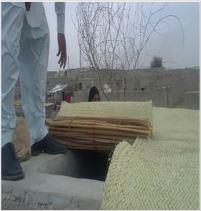 Breeding in man-made habitats such as reservoirs, irrigation systems, irrigated fields and borrow-pits can sometimes be prevented by proper planning and design to make them unsuitable as breeding sites or to facilitate the implementation of control measures.The goal of the study was to demonstrate cost effective, sustainable and alternative larval control methods in the Islamic Republic of Iran for assessing the effectiveness of different coverings (straw mat and tile covered with a thin layer of concrete) and a bacterial larvicide on water cisterns. The study design was a randomized selection of three clusters. In the first cluster water cisterns were covered with straw mats. In the second cluster, the intervention included covering the reservoirs with tiles supported with metal frames and a thin layer of concrete while bacterial larvicide was applied in the third cluster.
Breeding in man-made habitats such as reservoirs, irrigation systems, irrigated fields and borrow-pits can sometimes be prevented by proper planning and design to make them unsuitable as breeding sites or to facilitate the implementation of control measures.The goal of the study was to demonstrate cost effective, sustainable and alternative larval control methods in the Islamic Republic of Iran for assessing the effectiveness of different coverings (straw mat and tile covered with a thin layer of concrete) and a bacterial larvicide on water cisterns. The study design was a randomized selection of three clusters. In the first cluster water cisterns were covered with straw mats. In the second cluster, the intervention included covering the reservoirs with tiles supported with metal frames and a thin layer of concrete while bacterial larvicide was applied in the third cluster.
Results
The risks of P.falciparum and P. vivax transmission in Chabahar city were very low with evidence of limited recent transmission. None of the examined blood subsets using light microscopy and nested - Polymerase Chain Reaction (PCR) assays were positive for P.vivax and/or P.falciparum parasites.
On going activities include: assessing durability and sustainability; assessing community acceptance; conducting knowledge, attitude and practice survey following peer-to-peer education; analysing cost-effectiveness of larval source management interventions and planning for expansion of selected interventions to all Chabahar areas.








